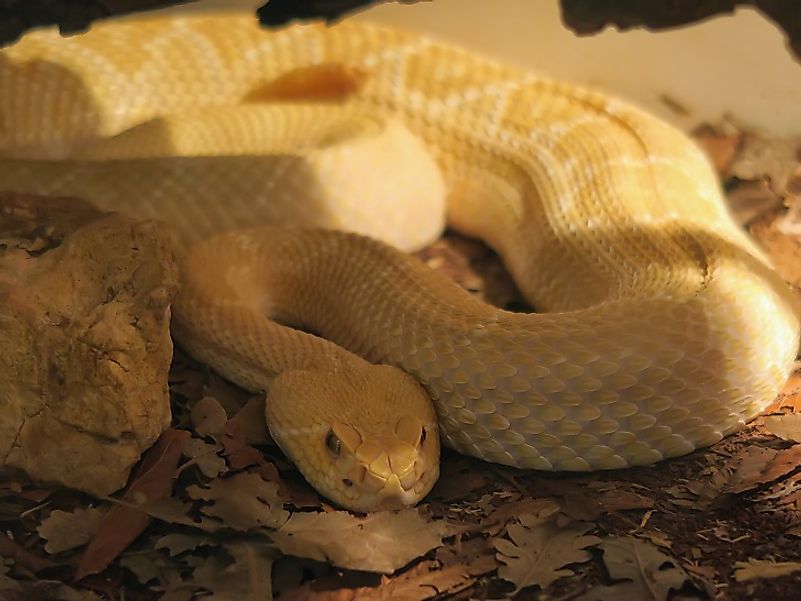Killer Snakes Of North America

10. Western Diamondback Rattlesnake

The Western Diamondback rattlesnake (Crotalus atrox) is a highly venomous species of rattlesnake found in the U.S. and Mexico and is responsible for the greatest number of snakebite fatalities in Mexico. The venom of the snake is hemotoxic and proteolytic in nature and though the toxic potency of the venom itself is lower than that of most other rattlesnakes, the large fangs and venom glands of the snake trigger the delivery of large volumes of venom into the bite victim, leading to more harmful consequences. The average venom injected in a single bite can be as high as 700 to 800 milligrams.
9. Timber Rattlesnake

The Timber rattlesnake (Crotalus horridus) is the most northerly distributed species of rattlesnake which is endemic to the United States. The snake has a mild disposition but produces large volumes of highly toxic venom whose composition varies widely with the geographical range of the species. Four types of venom patterns have been observed in the timber rattlesnakes, including neurotoxic-only venom (in Type A), hemorrhagic and proteolytic venom (in Type B), a combination of Types A and B, and Type C, the last of which is less potent than the others.
8. Tiger Rattlesnake

The Tiger rattlesnake (Crotalus tigris) is known to be the second most venomous rattlesnake species. However, its relatively shorter fangs and lower venom yields often act as a life saver in humans bitten by this snake. The range of this species of pit viper extends from northwestern Mexico to the southwestern United States.
7. Prairie Rattlesnake

The Prairie rattlesnake (Crotalus virdis) has a widespread population ranging from northwestern Canada throughout western United States to northern parts of Mexico. The snake produces a potent venom that has both neurotoxic and hemotoxic properties. The prairie rattlesnake reacts by biting when threatened and injects around 20-55% of venom with each bite.
6. Mojave Rattlesnake

The Mojave rattlesnake (Crotalus scutulatus) is extremely feared in North America for its deadly venom that can easily kill an adult human being if not treated in time. The snake inhabits the desert regions in southwestern U.S. and central Mexico. Two subspecies of Mojave rattlesnake produce two variants of venom, the type A is a highly potent neurotoxin which is held to be the most deadly venom among all rattlesnakes while the type B venom is a hemotoxin which is about 10 times less potent than the type A poison.
5. Eastern Eastern Diamondback Rattlesnake

The Eastern Diamond rattlesnake (Crotalus adamanteus), a snake species inhabiting southeastern United States is one of the country’s most feared snakes, well known for its powerful built and potent venom. The mortality rate from the snake bite is about 30%. The eastern diamondback’s venom is a toxic cocktail of components that has hemorrhagic, cardiotoxic, proteolytic, and necrotizing actions.
4. Eastern Coral Snake

The Eastern Coral snake (Micrurus fulvius) is endemic to the Southeastern U.S. and, though highly venomous, is associated with a low fatality rate. The most recent fatality case due to eastern coral snake bite was reported in 2006. Though the coral snake is known to store enough neurotoxic venom to kill five adult human beings, its timid nature, reluctance to bite and low volume of injected venom makes it less deadly than many other venomous North American snakes.
3. Cottonmouth

The Cottonmouth (Agkistrodon piscivorus ) is a venomous species of pit viper from southeastern U.S. that produces a toxin that is potentially fatal. The cottonmouth is infamous for its aggressive nature and frequent confrontations with humans. However, though bites from this species of snake is relatively common, death is rare due to the easy availability of antivenin. The venom is primarily cytotoxic in nature with the ability to damage the tissues of the body.
2. Copperhead

The Copperhead (Agkistrodon contortrix), a venomous species of pit viper closely related to the cottonmouth is found throughout eastern North America. Though the venom produced by this species could be potentially fatal in significant doses, in reality very few fatality cases are associated with this snake. Even when threatened, the copperhead often injects very small amounts of venom or inflict “dry bites” with no venom at all.
1. Black Diamondback Rattlesnake

The Black Diamondback rattlesnake is a deadly species of pit viper found in the state of Baja California in Mexico and the southwestern U.S. The venom produced by this snake is a fatal cocktail of myotoxins that can paralyze the muscles including the heart, neurotoxins that can attack the nerves, and hemotoxin that ruptures blood cells.











